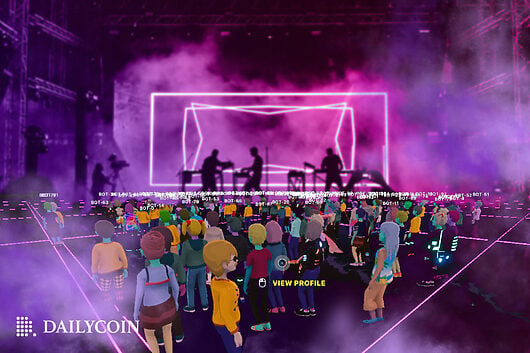Fans Gather At Decentraland: Is Metaverse Music Festival Worth Your Virtual Sweat?

The past couple of days were not easy for crypto, but it’s not all drama in the Web 3.0 sphere. The annual Metaverse Music Festival hosted by Decentraland and Kraken kicked off on Thursday, inviting fans to witness more than 170 artists on over 15 stages.
The fans could tune into the virtual world from the 10th of November to the 13th, and attend hundreds of gigs that, according to festival’s producer Iara Dias, were “designed to recreate some of the aspects of real-life music festivals while simultaneously playing with new possibilities in the metaverse.”
Metaverse Music Festival organizers describe the event as “a four-day celebration of music, innovation, culture, and creativity.” Let’s look at what attending the metaverse music festival feels like and whether it is worth your virtual sweat.
Famous Names in the Line-up
In its official communication, festival organizers highlight some well-known artists performing in the metaverse. One of them is the renowned global touring metal festival OZZFEST. The brand has its fortress-looking virtual stage built on Decentraland, hosting a line-up of heavy-music bands, including Ozzy Osbourne himself.
The festival is famous worldwide, as it helped launch the careers of numerous bands such as Slipknot, Disturbed, System of a Down, and many more. Other iconic names announced in the festival’s line-up are Dillon Francis, Soulja Boy, Motörhead, Megadeath, Akira the Don, Gramatik, Yokoo, Arapu and PlastikFunk, Salem Ilese, Lum feat. Mads.
It is the second time the digital creators and Decentraland are trying to mobilize metaverse users to participate in a virtual music festival. Last year, fifty thousand unique users attended the four-day event. The festival’s line-up consisted of more than 80 artists, including world-famous names like Deadmau5, 3LAU, Paris Hilton, RAC, and Alison Wonderland.
How Does Attending the Festival Actually Feels?
Preparing for a virtual music festival definitely does not include packing your tent, raincoat, or boots. Even though accessing the metaverse by default always seems to include the VR glasses, logging in to Decentraland is possible via an internet browser. Your computer’s graphic card and working memory need to be quite powerful to render 3D environments that are updated live.
After connecting your wallet and creating an avatar, you are teleported into the Decentralands platform, where navigating through the map, attendees can find different virtual venues with festival events. Futuristic 3D-generated spaces are impressive; however, you cannot help wondering – where are the people? Is this a concert without an audience?
According to DappRadar, on the 9th of November, there were an average of 660 unique active wallets on Decentraland. On the first festival day, November 10th, the numbers had risen to 904. It is unknown how many users participated without using a wallet, as Decentraland also grants access as a ‘Guest.’
Recently, there was a dispute between DappRadar and Decentraland, as the analytical tool tracks the active wallets and transactions. Decentraland claimed that metaverse users often perform activities without interacting with the blockchain. That’s why the on-chain activity is low. However, despite the possible results in numbers, the feeling of the festival is one of emptiness.
In some venues, there are no people at all, so your lonely avatar could experience a solo concert. In other places, there are some avatars hanging out. However, the interactions between them are minimal.
To communicate, users can use a chat screen at the corner of the screen. For example, in OZZFEST, communication mainly consisted of discussing technical issues and complaining about the performance.
Covid-19 forced many to onboard digital experiences. When the world got back to its normal rhythm, the question remained how the metaverse could alter entertainment. Why should people choose to sit with their devices instead of going out to something real?
Some of the festival’s events seemed not to be metaverse-native. Every platform and form of expression requires a specific genre. The metaverse is still under development, trying to define itself. Still, some things just do not feel right.
Some events limit the experience to simply broadcasting the footage of the real event, or a band’s music video. Video-sharing platforms were developed decades ago, so going into the metaverse to watch a YouTube video is rather underwhelming. Metaverse event organizers should think outside the box. They should create specifically for this medium, instead of trying to emulate the tangible world.
On the Flipside
- Despite the low interest in the music festival, Decentraland land NFTs remain popular. According to the trading volume data given by Opensea, there was a significant increase in Decentraland land NFT sales. Also, Decentraland remains third in the top collections traded on the Opensea NFT marketplace.
- Decentraland’s strength remains virtual land sales. Virtual land in Decentraland, tokenized as an NFT, was recently sold for $3,818 (5.980 MANA). The price is 1.70x the current floor price. The land NFTs are made up of nearly 97,000 pieces of land, each of which is 16m × 16m, or 52 square feet.
Why You Should Care
According to the newest report by consulting firm McKinsey & Company, global expenditure in the Metaverse could hit $5 trillion in 2030. The creator economy is sure to be a crucial part of the metaverse, as it enables the monetization of digital experiences. It also acts as the driving force for the creation of thriving digital communities.
Read more about Metaverse Art Week on Decentraland:
The World Is Made Of Code: Decentraland (MANA) Kicks Off Annual Metaverse Art Week
Read more about Frida’s Kahlo art being placed in the metaverse:
Frida Kahlo’s Artwork Will Be Permanently Displayed on Decentraland Metaverse
Text source: DailyCoin.com










